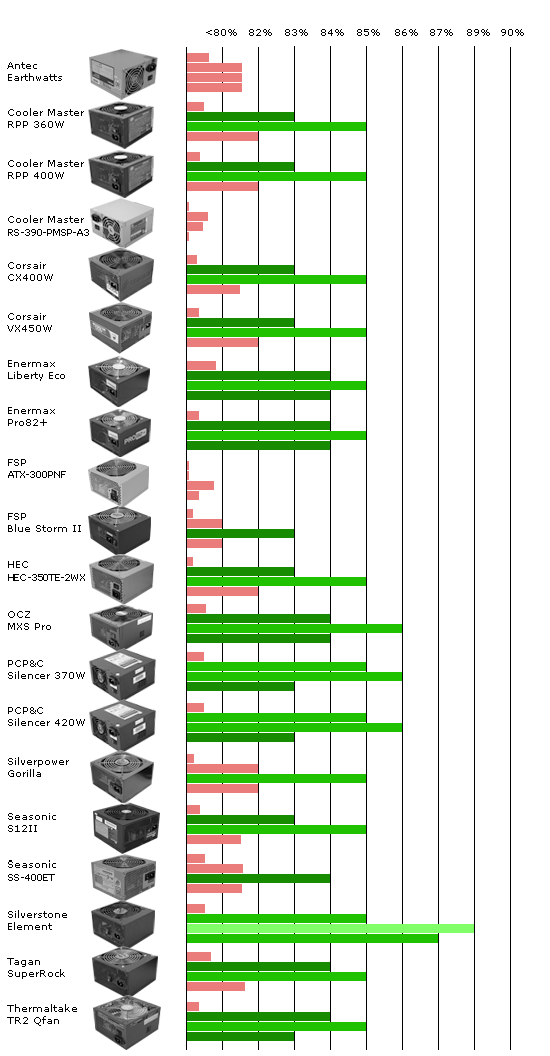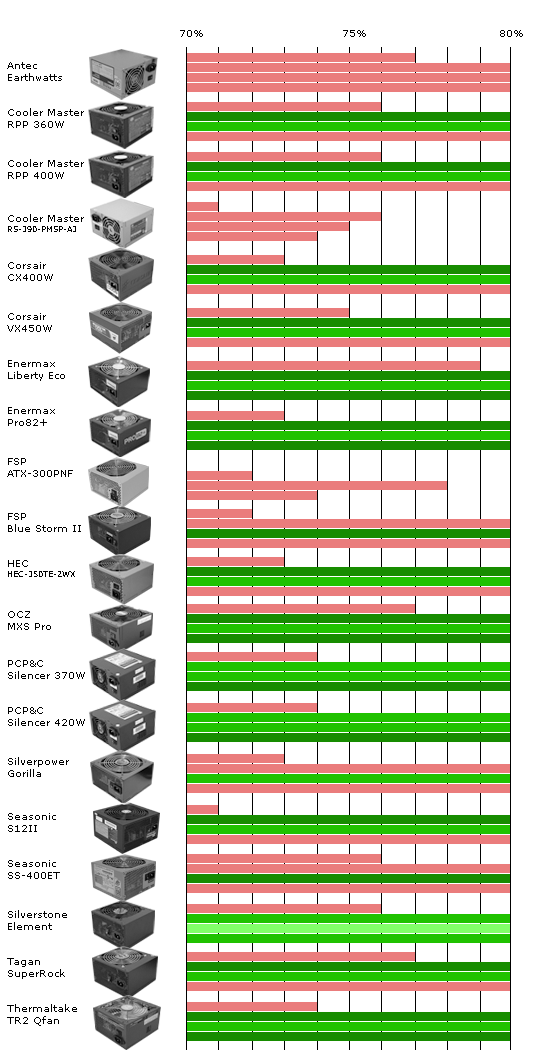300W to 450W: 20 Power Supplies on the Test Bench
by Christoph Katzer on December 31, 2008 6:00 AM EST- Posted in
- Cases/Cooling/PSUs
Efficiency Comparison
The problem most users do not realize today is that if you have lower wattage units you cannot really have the latest technologies inside since it just doesn't make sense. Fancy components and features costs money -- it doesn't matter if they are in an 800W or 300W unit. If you make a small power supply with very high quality features, the user will need to pay for it. The unfortunate truth is that there would be nobody out there willing to pay $150 for a 300W power supply because there are tons of options with prices starting as low as $20. The important thing is to know why you want to have a better quality product, which for most people today is the higher efficiency these units can deliver. If you have a price difference of $50 from your product of choice to a higher efficiency power supply with similar specs, then it will most probably not make any sense since you will need to run the power supply for several years 24/7 to overcome the initial investment.
We discussed this in our article about power consumption and why it is so important to know more about your PC and its components. With today's products we see 82% as a mark every high-end product should be able to reach, which is why we start from 82% with a green graph. Everything below will be red just to show you the efficiency wasn't that good. Don't be worried about the first graph of each power supply since that represents 10% load and no power supply that went through our hands was ever able to come even close to 80% with such a low load. This is why 80 Plus certification for example starts at 20% load. The second graph represents 20% load, the third 50% and the last represents full load. Here again, the more green bars a power supply has the more efficient it is. All of the efficiency results shown are with 230VAC for ease of comparison; efficiency will be slightly lower on 120VAC.

Since the manufacturers are primarily focusing on higher wattage power supplies with new technologies that bring better efficiency, we didn't expect any miracles today. However, some units again stand out from the crowd. Many of the power supplies reach 85% efficiency, which is a very good development. Power supplies from Enermax, OCZ, PC Power & Cooling, Silverstone, and Thermaltake show very good results. The Silverstone Element tops out at incredible 89% efficiency, which puts it at the top of the group a second time.
The following graphic shows the efficiencies below 80% which wasn't possible to include before. Please note the efficiency at 10% load of the FSP OEM unit is with only 61% not visible.











39 Comments
View All Comments
Martin84a - Monday, January 5, 2009 - link
I think it says the german and the english site, run things pretty seperately.250watt, 16a on the 12v rail that results in a ~300mV ripple. That's a lot. We are not even talking 80% or 100% of its max rated capacity.
I know that are "allowed" to vary 10% on the 12V rail, but i still think it is a testament to the quality of the PSU. Look at the competetion next to it, nearly straight line.
I recently had an Antec Truepower 480 watt dying on me. I had it for a little more than 3-4 years. Prior to buying it i did a tons of research. Anandtech also gave it a very good score. Today it is clear that a lot of these has failed, because of some very shitty caps being used. You don't see this in most of the reviews, because they only test if for a day or a week or so. Warranty is a big deal for a lot of people, including myself. I won't buy western digital or maxtor anymore, because i have had too many dying on me, granted they have been running for 3-4 years. Seagate give a 5 year warranty as the only HDD manufactor, so of course i pick them.
The same with PSU's, I still consider the Seasonic S12II a good PSU, but i would rather pick a PSU with a better warranty.
kenyee - Friday, January 2, 2009 - link
They just don't make them as well as they used to. I bought one of the expensive ones a year ago because it was the quietest around at the time...croaked after a month. Didn't bother sending it back under warranty because I didn't think it was worth it. It also doesn't support older 2.0 systems which I did send it back to them for but they could have told me via email :-PFinraziel - Thursday, January 1, 2009 - link
Although I understand what you're saying about the 10% load and how no PSU comes close to 80% efficiency there, would it be possible to still post the actual results of the different psus rather than only the rather blunt comparison in the graph? Many systems may not go far below 20% load with these psus, but if you're intent on setting up a very efficient pc it's not that hard to approach or even duck onder 30 watt idle. So in those cases, even though it's not close to 80, it'd still make a big difference wether the efficiency is 50, 60 or 70%...Christoph Katzer - Thursday, January 1, 2009 - link
Did a small update to the efficiency page. Thanks for the suggestion.sonci - Thursday, January 1, 2009 - link
So, best PSU regarding efficiency should be ENERMAX Liberty ECO, cause for 24/7 use, you hardly need 50% load..?Christoph Katzer - Thursday, January 1, 2009 - link
Depends on your system power requirements. There is a difference if you just need 50 watts or 150. Check the power consumption first, then check in which state you are running most of the time and then check which PSU would fit best. From some of the tested units we have separated reviews already where you can check the exact efficiency at a specific load.JonnyDough - Wednesday, December 31, 2008 - link
You really DO listen to your readers! KUDOS. You're one of the few companies that does.sonci - Wednesday, December 31, 2008 - link
AnandTechThankyou for your honest work..
Happy new year!!
JeBarr - Wednesday, December 31, 2008 - link
I can vouch for the S12II 330W and it's ability to run an hd 4850. Originally I had installed the FSP group ZEN 400W fanless, but due to orientation of PSU inside of htpc case did not allow the heatsink to function as designed, so I gave the seasonic a try and have no regrets. It also helps that the rest of my components are low-power, of course.marc1000 - Wednesday, December 31, 2008 - link
why does akasa products never show on Anandtech?? well, I have one Akasa AK-P300PG (or something like that), it's a 300W unit. I used to power a Pentium-D 945 with a radeon 3850 (now i have a C2D e7200) and it works just fine. silent and stable power. It's a great product that could be included in future reviews.by the way: HAPPY NEW YEAR!!! :D